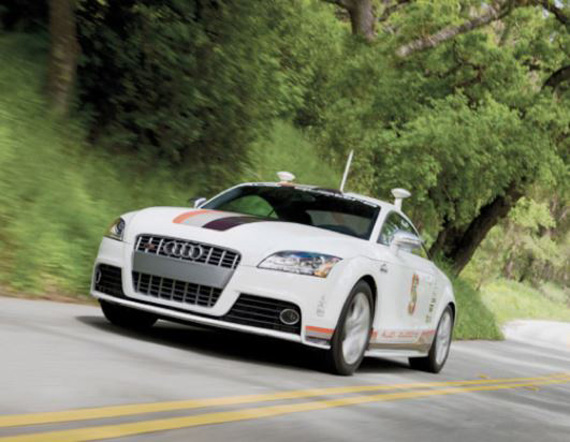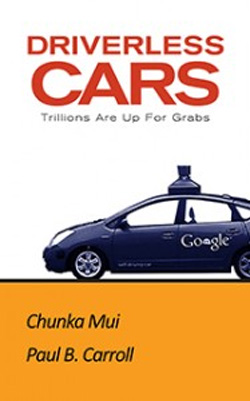
The Rinspeed XchangE concept car offers passengers virtually any seating or resting position and the interior they want and provides the relaxing business-class comfort found with major airlines. The seats allow more than twenty possible seating arrangements with a host of adjustment, tilting and swiveling options.
Part 1 of ADA revealed a long history of attempts to create a self-driving automobile, while Part 2 discussed the political, social and legal issues confronting such vehicles. In Part 3, Gijsbert-Paul Berk considers the needs and fears of the marketplace.
Aside from legal, political, and social issues, a growing market for ADAs also depends to a large extent on the price and consumer trust.
That there exists a market for such cars is beyond doubt. There are sufficient people who dislike driving in today’s dense traffic; some of the younger generation will certainly prefer sending SMS message with their smartphone or playing with their tablet over concentrating on the traffic around them. In Europe and the U.S. there are a great number of older drivers who are conscious that their reaction time is gradually slowing down or who have other minor handicaps.
The China Syndrome
1. – Reduce accidents. Part of the reason China has a higher rate of accidents and traffic fatalities than the U.S. is that many drivers are relatively inexperienced. Self-driving vehicles such as Google cars would solve this by preventing human errors.
2. – Reduction of traffic congestion and air-pollution. Traffic jams are an increasing headache; the robots in control of self-driving cars should be able to plan their routes so efficiently as to avoid traffic building up.
3. – Improve productivity of people and stimulate self-education while commuting. Because as the robots of the ADA will sort out the traffic issues, all on board of the car are free to work on their laptops.
4. Supporting and stimulating this new technology have important economic and fiscal advantages for countries in Asia. The governments could reduce their investments in roads, and save the expenses of installing traffic lights and road signs everywhere.
For thousands across the globe, autonomous cars will provide an attractive alternative to traditional driving.
The Cost of Self-Drive
Most of the technology for self-driving automobiles is already available today. One can order them as options on several premium models. There are accident-avoiding systems such as adaptive cruise control, that automatically brake before you drive into a car in front and radar to prevent you hitting pedestrians. One can also order lane swerving warning or driver alert systems that wake you up when your car swerves because you are falling asleep behind the steering wheel. Some makes even offer systems to assist parking. These take over the trouble of reversing into a parking space. But all those advanced high-tech systems are still very expensive.

One of the Google test cars, a Lexus, reveals its secrets. It must be said that up till now Google has done more to promote the idea of driverless cars than any of the major car manufacturers. But maybe they are more cautious because of the risks of product liability lawsuits.
Some time ago Google revealed that the electronics and robots they used on the Lexus and Toyota Prius ADA test cars cost over $80,000. Taking into account the observations from the famous Moore’s law, the self-drive systems will of course in time become more affordable.
But still!
The HAL Syndrome
Apart from the price of self-driving cars, it seems that at the moment in the U.S. only a minority of potential customers are eager to switch to an ADA, perhaps recalling the flawed spacecraft-driving robot HAL in “2001 A Space Odyssey”.
J.D. Power and Associates, in their 2013 U.S. Automotive Emerging Technologies Study, found that only one in five customers were interested in autonomous cars. Most respondents expressed concerns about whether self-driving cars were dependable, their juridical liability, and how driverless cars would co-exist with cars that were driven by humans.
The results of the J.D. Power survey were confirmed by a Harris Interactive poll commissioned by Seapine Software. 88 % of currently licensed drivers describe themselves as being “worried about riding in a driverless car.” Drivers over 55 years of age are significantly more worried about driverless-travel than drivers 34 years of age and younger (93 % to 84 % respectively).
Reasons for concern include: Fear of equipment failure (79 % of the respondents); liability issues (59 %); hackers taking control of vehicle (52 %); and exposure of personal data including destinations and speed traveled (37 %).
Another study by the accountancy group KPMG and the Centre for Automotive Research (CAR) concluded that drivers were only interested in self-driving cars if these could use dedicated lanes and reduce commuter time by half. And, in a survey of 2000 people conducted by Carinsurance.com, an online car insurance and rate quote company, 80 % of the respondents said that they would not buy an autonomous car if one were available today. Main reason given: Lack of confidence in the ability of computers to make driving decisions equal or better than human beings. Many said they would not trust an autonomous vehicle to take their children to school.
Watch the video above to see a wide range of people experience the Google ADA.
However, 90 % confessed that they would consider buying a self-driving car if it would mean a substantial reduction (say 80 %) of the insurance rate. But Bryan Reimer, a research scientist at the Massachusetts Institute of Technology, predicts that the technology of autonomous vehicles will increase the cost of damage repairs considerably. “A bumper loaded with sensors is more expensive than a regular bumper.”
The Edsel Syndrome
The above-mentioned outcomes of serious surveys seem hardly promising for the economic feasibility and thus the future of ADA’s. We must bear in mind that Steve Jobs, with his Macintosh PC, iPod, iPhone and iPad probably the most important ‘creator’ of new products since 1980, never believed in market research “…because customers don’t know what they want until we’ve shown them. Did Alexander Graham Bell do any market research before he invented the phone?” And Henry Ford once said, ‘If I’d asked the public what they wanted, they would have told me, ‘A faster horse!’ You have to read things that are not yet on the page.” Then of course there was the Edsel, which failed despite a huge and costly market research effort.
Back to the Future
“Trying to predict the future is like trying to drive down a country road at night with no lights, while looking out the back window.” I was reminded of these wise words of the late management consultant Peter Drucker. Not only because I realize that driving down a country road at night without lights will be perfectly feasible with autonomous automobiles. I also belief that it is a sensible advise to look from time to time in your mirror through the back window and analyze past experiences.
As with all new products it is extremely difficult to forecast the future of self-driving automobiles. Only one thing seems certain: During the coming decade the auto industry will offer an increasing number of high-tech driver assisting systems in their premium range of cars, to make driving more comfortable and safer. As the price of these electronic options comes down they will gradually also become available in less expensive models, just as has happened with brake assistance, air-conditioning and GPS. Therefore in a few year’s time it may be possible, when we are on a motorway, to switch on the ‘automatic pilot’ like today we set the speed control, type our destination in the GPS monitor and switch the radio to receive the traffic information that interrupts regular radio programs or the music from our iPod.

Apart from the costly modern weapon systems manpower is still the greatest expense post in defense budgets. It is not only the costs of pay, training and pensions, but soldiers also need equipment, clothing, food, shelter, medical care, recreation, and the logistic means to supply them. This is why the US Army is presently testing self-driving trucks for its supply lines. In May, it ran an unmanned convoy of seven different tactical vehicles driving at over 40 mph (64 km/h) at the US Department of Energy's Savannah River Site in South Carolina. A second test with soldiers and marines is scheduled for August.
That said, it is not very likely that in the near future we will see ADAs without a steering wheel transporting civilians on public roads – the military will see this first. Does this mean that Google’s experiments with autonomous driving cars are not going to pay off? I think they will. Their scientists are active in many fields. Earlier this year, Google announced that it had developed a glucose-monitoring contact lens aimed at helping people with diabetes to better manage their disease. Recently Google formed a partnership with Alcon, the eye care division of the Swiss Pharmacist Novartis, to commercialize this technology. The results of Google’s experience with ADAs will certainly lead to new discoveries that can be patented. Patents and licensing rights have become vital assets in the modern industrial world.
Look Ma, no FUN!

There are no autonomous-driving sports cars - yet. And one wonders who will want such a car. But this Audi TTS ‘Shelley’, developed by Chris Gerdes and his colleagues at the Center for Automotive Research at Stanford University, is the nearest thing. Its robot system relies on GPS, wheel speed sensors and traction control algorithms to lead the car to drive 'to its limits.' The Audi Shelley demonstrated its performance on the famous 12.42 mile (19.99 km) long Pikes Peak hill road circuit with its 156 turns, climbing over 4,720 ft. (1,440 m.). It sprinted to the top in 27 minutes. In 2013 Sebastian Loeb, with his Peugeot 208 16T Pikes Peak, set the record at 8:13.878. If the Stanford team did not come very near this time, they proved that their autonomous-driven Audi was capable of outperforming an average driver. By the way, the name Shelley was inspired by Michele Mouton, a French rally driver and the first woman to win the Pikes Peak International Hill climb.
Listening to some politicians and political think tanks one gets the impression that they see autonomous driving cars as an opportunity to ‘tame the unruly masses of individual motorists who make our planet unsafe’. If they get their way the ADAs of the future will be the embodiment of: Big Brother is driving you!
Fortunately in the industry that earns its bread with producing and selling automobiles, most top managers have more pragmatically ideas.
At the launch of the new Mercedes-Benz S class last May, Daimler-Benz CEO Dieter Zetsche claimed that his new S class “marks the start of the era of partially autonomous driving.” Indeed, with its six eyes (cameras) and six ears (radar sensors), the new up-market Mercedes S can see and hear enough to drive itself at speeds up to 60kph (37mph). But at the same occasion Zetsche declared: “Our ultimate goal is to remove the boring parts of driving but keep the fun. We will never automate the cool part of driving … the uncool part, though, we can do without.”

Today it is hard to imagine that one day we will drive cars without a steering wheel and nice clear and analog dashboard instruments. But probably the time will come when we will enjoy the comfort of a robotic chauffeur to drive us. Then we’ll show our great grandchildren the cockpit of an Alfa Romeo Guilietta Spider from around 1960. We will then tell them how we enjoyed driving these machines that had no power steering, gps or even cruise control. And they will look at us incredulously.
Wolf-Henning Scheider is responsible at Robert Bosch for the development of chassis system units. His company supplies many car manufacturers and he fully agrees with the Daimler-Benz boss: “There are many situations where driving is real fun and you’ll want to do the driving yourself. But there are also situations where you’ll think I could use my time better. Take day-to-day commuting and traffic jam situations; then automated driving functions prove their worth.” Scheider added a warning “Although many of the pieces such as sensors that can control braking, steering, speed and the distance between vehicles are already available in models like the S class, BMW 7 series and Volvo XC60, fully autonomous cars will not be a reality until they are proved 100 percent safe at 100 percent of the time.”
Bibliography:
– ‘Clean, safe and it drives itself ‘ (The Economist 20 April 2013).
– ‘Auto correct’ by Burghart Bilger (The New Yorker 25 Nov. 2013).
– ‘Autonomous Cars Through the Ages’ By Tom Vanderbildt (on Twtter).
– http://www.argo.ce.unipr.it/argo/english/index.html
– Websites of all named car and equipment manufacturers.

One flaw not addressed here; what happens to the ADA when another car driven by an incompetent (drunk, crazy, comatose etc) driver rear ends it, or runs a red light at high speed? Until all traffic is working to the same system I doubt the cleverest robotics can predict the unpredictable. If a human is at the controls and is aware and alert it is possible sometimes – not always of course – to take evasive action.
It’ll take generations for these things to become acceptable. I already resent the manufacturers denying me a handbrake in a new car, and simply wouldn’t buy one with an electric alternative. My local auto repair guy loves them though, as he makes on average £900 a year extra income per car from replacing them when they inevitably fail. I really can’t understand what manufacturer would risk the potentially hideous litigation that would result from an ADA systems failure. Don’t they already use computers? Do they really think they can be made reliable – let alone failsafe?
I think ADA’s will be useful in the same sense as a cruise control. You only use it when you need it as on the 5 hr drive
LA to Las Vegas thru the desert with the traffic more or less flows w/o intersections or sudden stops.
If you are nervous about using it in town, drive yourself. We don’t usually use the cruise control in heavy traffic either.